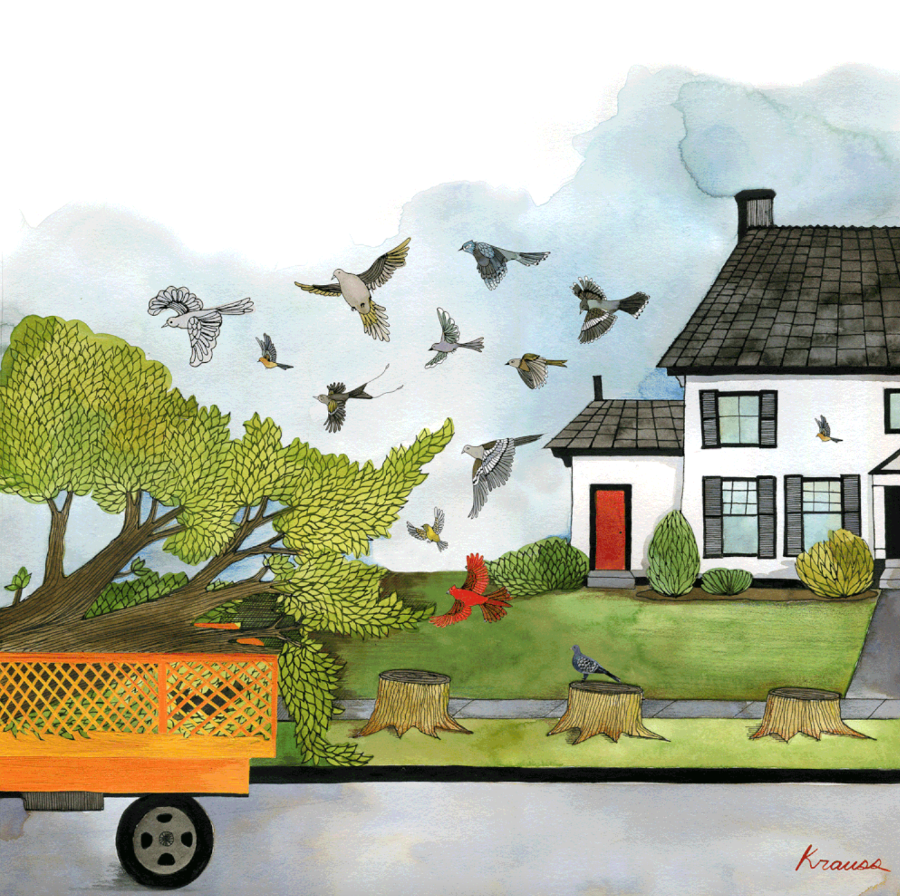Teach This Poem, though developed with a classroom in mind, can be easily adapted for remote-learning, hybrid-learning models, or in-person classes. Please see our suggestions for how to adapt this lesson for remote or blended learning. We have also noted suggestions when applicable and will continue to add to these suggestions online.
 Look closely at the illustration “Goodbye Sidewalk Trees” by Trisha Krauss.
Look closely at the illustration “Goodbye Sidewalk Trees” by Trisha Krauss.
The following activities and questions are designed to help your students use their noticing skills to move through the poem and develop their thinking skills so they understand its meaning with confidence, using what they’ve noticed as evidence for their interpretations. Read more about the framework upon which these activities are based.
- Warm-up: Read the definition of ars poetica. Rewrite the definition in your own words. Why might a poet write an ars poetica?
- Before Reading the Poem: Look closely at the image of the illustrated piece “Goodbye Sidewalk Trees.” What stands out to you in the illustration? Why? Where might these trees be going?
- Reading the Poem: Silently read the poem “The Creative Drive” by Catherine Barnett. What do you notice about the poem? Note any words or phrases that stand out to you or any questions you might have.
- Listening to the Poem (enlist two volunteers to read the poem aloud): Listen as the poem is read aloud twice, and write down any additional words and phrases that stand out to you.
- Small-group Discussion: Share what you noticed about the poem with a small group of students. Based on the details you just shared and the resources from the beginning of class, discuss: is this poem an ars poetica? What might this poem say about writing? How does that compare or contrast with the title “Creative Drive”? What drives the speaker?
- Whole-class Discussion: Re-read the line “Over the next thirty years, there won’t be any poems where there are overhead wires.” What does this mean to you? How might the world be different in ten, twenty, or even thirty years? What will be the same and what will be missing? Read the “About the Poem” statement at the bottom right corner of the page. How does this information impact your reading of the poem? Why?
- Extension for Grades 7-8: In honor of National Poetry Month, use Barnett’s poetic formula to write your own cento. Choose an article from a newspaper and use “the raw material” or language from the article that you find interesting and add “substitutions” like Barnett did with the word tree. Feel free to be creative. Share your cento with your class and discuss how you felt during the writing process.
- Extension for Grades 9-12: In honor of National Poetry Month, read more ars poetica poems. Then, write your own ars poetica poem and create an image to accompany your poem. Share your poem and image with the class. (Teachers, you may wish to display all of the ars poetica poems. You can find more lessons about ars poetica.)
The essay “On ‘The Red Wheelbarrow’” states “Artists often say that a work of art is about itself and something else. In this way, a poem can be an ars poetica, a statement by the poet about poetry, about his or her beliefs about what poetry is and about what it does.” Read the essay on Poets.org.
